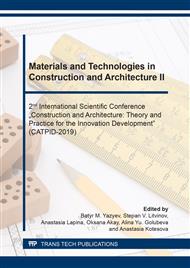p.14
p.20
p.26
p.31
p.37
p.43
p.49
p.55
p.61
Study of the Influence of Thin-Dispersed Powders on the Structuring Ability of Stabilizing Additives
Abstract:
The article presents the results of the study of the bitumen-retaining ability of stabilizing additives developed on the basis of cellulose-paper waste and finely dispersed fillers of various genesis. Analysis of the test results of crushed stone-mastic asphalt mixtures of the same composition showed that all additives provide the value of the runoff index of the organic binder in the mixture, which meets the requirement of the State Educational Standard No. 31015-2002. The introduction of mineral fillers into the stabilizer contributes to a decrease in the studied parameter, which is due to the additional structuring effect. For a two-component additive (without mineral filler), the studied indicator has the greatest value, exceeding the recommended limit. It is important to note that the use of mineral powder in the composition of stabilizing additives has a positive effect on the flow of the binder. Mineral powder, due to the structuring effect on bitumen and the formation of a microporous structure, reduces the run-off rate of the binder. This is due to the fact that bitumen, being in thin interlayers and small pores, falls into the region of influence of the molecules of the surface layer of the mineral part, increasing the density of granules and facilitating the granulation process of the additive. The minimum runoff of the organic binder is observed in the preparation of crushed stone-mastic asphalt-concrete mix with additives based on mechanically activated wastes of wet magnetic separation of ferruginous quartzites and is 0.07.
Info:
Periodical:
Pages:
37-42
Citation:
Online since:
December 2019
Authors:
Price:
Сopyright:
© 2020 Trans Tech Publications Ltd. All Rights Reserved
Share:
Citation:


